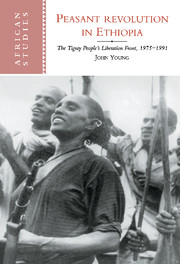Book contents
- Frontmatter
- Contents
- List of maps
- A note on names, transliteration and the Ethiopian Calendar
- Acknowledgements
- 1 Ethiopia
- Introduction
- 1 Peasants and revolutions: theoretical directions
- 2 Historical and social background
- 3 Tigray on the eve of insurrection
- 4 Struggle for opposition ascendancy: 1975–1978
- 5 Challenges and advances: 1978–1985
- 6 Triumph 1985–1991
- 7 TPLF and the peasants
- 8 Conclusion
- Notes
- Bibliography
- Index
- Titles in the series
1 - Peasants and revolutions: theoretical directions
Published online by Cambridge University Press: 12 November 2009
- Frontmatter
- Contents
- List of maps
- A note on names, transliteration and the Ethiopian Calendar
- Acknowledgements
- 1 Ethiopia
- Introduction
- 1 Peasants and revolutions: theoretical directions
- 2 Historical and social background
- 3 Tigray on the eve of insurrection
- 4 Struggle for opposition ascendancy: 1975–1978
- 5 Challenges and advances: 1978–1985
- 6 Triumph 1985–1991
- 7 TPLF and the peasants
- 8 Conclusion
- Notes
- Bibliography
- Index
- Titles in the series
Summary
Introduction
In 1974 a popular movement brought down the faltering old regime of Emperor Haile-Selassie, but it was a military cabal, the Derg which assumed state power. Unwilling to share power with civilians or acknowledge the right of Ethiopia's nations to self-determination, the Derg was challenged on many fronts: from a reinvigorated secessionist movement in Eritrea, student radicals in the urban centres of Ethiopia, and a host of rural-based national insurgencies. In these chaotic conditions a small group of university students launched a national liberation struggle in early 1975 from the desperately poor province of Tigray. With approximately 3.1 million people, Tigray possesses about 5 per cent of Ethiopia's population, has no industrial base or valuable exports, and its overwhelming population of peasants had the highest percentage of landholders in imperial Ethiopia.
In spite of the TPLF's inauspicious and largely ignored entrance on to the revolutionary stage, with the overwhelming support of the province's peasants, the movement captured Tigray in 1989, and went on to lead a coalition of ethnic-based movements that assumed state power in 1991. With this turn of events it has become ever more pressing to develop an understanding of the basis and course of the Tigrayan revolution and the means by which the Front mobilised the peasantry of the province. These are the main objectives to which this study is directed, but to approach them there is a need for theoretical direction in approaching the problem of revolution.
- Type
- Chapter
- Information
- Peasant Revolution in EthiopiaThe Tigray People's Liberation Front, 1975–1991, pp. 16 - 37Publisher: Cambridge University PressPrint publication year: 1997

